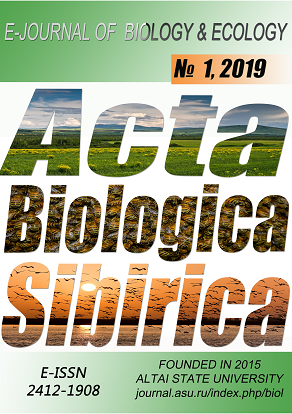Abstract
We founded that E. finlandicus and K. aberrans formed the nucleus of Phytoseiidae community on the plants of urbanized environment in the result of study of 93 plant species (55 species of tree-and-shrub (58.9%) and 38 species of herbaceous plants (41.1%). Our research was carried out in plantations along the main and secondary municipal highways, near residential area and industrial buildings, on private plots of the private building area, in city parks and squares of Kyiv, Uman, Brovary, and Vasylkiv (Ukraine). The peculiarities of their distribution among urban plant associations, which differ from each other by different characteristics (population, area, degree of urbanization) were determined. Both species - E. finlandicus and K. aberrans have a rather extended range of indicators of relative biotope contiguity (-0.91<Fij<0.43 and -0.93Fij<0.96) that indicated their property to inhabit large number of plants. The indicator of K. aberrans occurrence, which was the highest in the city with the smallest degree of urbanization (Vasylkiv), decreased in the city with the maximum possible degree of urbanization (Kyiv). This indicator of E. finlandicus on the contrary increased along the gradient from a smaller city to the metropolitan city. K. aberrans inhabit a large number of plant species (33 species), while preferred plants from Rosacea family. E. finlandicus dominated by number of urban plant species it inhabited (75 species, 79.78%), absolute number of individuals in collected samples of predatory mites (504), occurrences index (Is = 74.49%), and by index of Palii-Kovnatsi (Di = 51.42%). The dominance of E. finlandicus species was registered in both groups of plants. The distribution of Phytoseiidae’s was primarily connected with the possibility of their movement along the surface of the substrate. Speed of mites moving was not the same in different species and depended on their morphology and plant morphology. Both species lived and laid eggs on the underside of the leaf. K. aberrans was more commonly found near the central vein of the leaf, while E. finlandicus was observed more evenly on the leaf plate, which can be explained by it higher vagility. K. aberrans could inhabit high number on fruit varieties of plants with pubescence leaves. Morphological features of plant leaves did not affect the spread of E. finlandicus species, therefore, they could be considered more "universal". However, it reached a higher quantity on the plants with a smooth surface of a leaf plate. Certain temperature, illumination regime, air and soil humidity caused the differences in mites spreading at various habitats.
References
Akimov, Y.A. Kolodochka, L.А., Zhovnerchuk, О.V., Omeri, I.D., Samojlova, T.P. (2007). Vydovoj sostav y ekologycheskye osobennosty kleshhej nadsemejstva Tetranychoidea (Acariformes, Trombidiformes) y semejstva Phytoseiidae (Parasitiformes, Gamasina), obytayushhyx na rastenyyax botanycheskyx sadov Kyeva (Ukrayna) (Species Composition and ecological perculiarities of mites of the superfamily Tetranychoidea (Acariformes, Trombidiformes) and family Phytoseiidae (Parasitiformes, Gamasina), inhabiting plants in botanical gardens of Kiev (Ukraine). Vestnik zoologii, 41(6), 521–534. (in Russian).
Broufas, G.D. & Koveos D.S. (2000). Effect of Different Pollens on Development, Survivorship and Reproduction of Euseius finlandicus (Acari: Phytoseiidae). Environmental Entomology, 29(4), 743–749. doi.org/10.1603/0046-225X-29.4.743
Demite, P. R., McMurtry, J. A., & Moraes, G. D. (2014). Phytoseiidae Database: a website for taxonomic and distributional information on phytoseiid mites (Acari). Zootaxa, 3795(5), 571-577. doi.org/10.11646/zootaxa.3795.5.6
Farazmand, A., Fathipour, Y., Kamali, K. (2012). Functional response and mutual interference of Neoseiulus californicus and Typhlodromus bagdasarjani (Acari: Phytoseiidae) on Tetranychus urticae (Acari: Tetranychidae). International Journal of Acarology, 38(5), 369–376. doi.org/10.1080/01647954.2012.655310
Grabovska, S. L. (2017). Species diversity of predacious phytoseiidae mites (Рarasitiformes, Рhytoseiidae) in vegetative plantations. Scientific Bulletin of UNFU, 27(5), 72–76. doi.org/10.15421/40270515
Grabovska, S.L., Mykolaiko, I.I., Mykolaiko, V.P. (2017). Structure patterns of phytoseiid mite communities in urban plant associations. Ukrainian Journal of Ecology, 7(4), 179–186. doi.org:/10.15421/2017_103
Hasselmann, К. (2003). Zur Bedeutung rauberischer Antagonisten fur die Populationsdynamik der Lindenspinnmilbe Eotetranychus tiliarium Hermann im stadtischen Grun. Thesis of Doctoral Dissertation. Doktors der Gartenbauwissenschaften. Hannover (in German).
Kabiček, J., Povondrova, K. (2004). Rhytoseiid mite communities on urban deciduous trees. Acta fitotechnica et zootechnica, 7, 119–121.
Kolodochka, L.A. (2006). Kleshchy–fytoseydy Palearktyky (Parasitiformes, Phytoseiidae) (faunystyka, systematyka, ekolohyya, evolyutsyya) (Phytoseiid mites of Palearctic (Parasitiformes, Phytoseiidae) (faunistics, taxonomy, ecology, evolution)). Vestnik zoologii, 21, 250 (in Russian).
Kolodochka, L.А. & Omeri, I.D. (2011). Khyshnye kleshchi semejstva Phytoseiidae (Parasitiformes, Mesostigmata) dendrologicheskikh parkov i botanicheskikh sadov Lesostepi Ukrainy (Predatory mites of the family Phytoseiidae (Parasitiformes, Mesostigmata) of dendrological parks and botanic gardens of the Forest-Steppe of Ukraine). Kyev (in Russian).
Kontschán, J. (2013). First recorded Phytoseiidae mites (Acari, Mesostigmata) from Albania Opusc. Zool. Budapest, 44 (suppl. 1), 133–137.
Murtry, J.A., Moraes, G.J., Sourassou N.F. (2013). Revision of the lifestyles of phytoseiid mites (Acari: Phytoseiidae) and implications for biological control strategies. Systematic and Applied Acarology, 18 (4), 297–320.
doi.org/10.11158/saa.18.4.1
Murtry, J.A., Sourassou, N.F., Demite, P.R. (2015). The Phytoseiidae (Acari: Mesostigmata) as Biological Control Agents. Prospects for Biological Control of Plant Feeding Mites and Other Harmful Organisms. Progress in Biological Control, 19, 133–149. doi.org/10.1007/978-3-319-15042-0_5
Pesenko, Yu. A. (1982). Principy i metody kolichestvennogo analiza v faunisticheskih issledovaniyah [Principles and methods of quantitative analysis in faunistic studies]. Nauka, Moskva (in Russian).
Puchalska, E.K. & Kozak, M. (2016). Typhlodromus pyri and Euseius finlandicus (Acari: Phytoseiidae) as potential biocontrol agents against spider mites (Acari: Tetranychidae) inhabiting willows: laboratory studies on predator development and reproduction on four diets. Exp Appl Acarol. 68, 39. doi.org/10.1007/s10493-015-9973-5
Sekrecka, M., Olszak, R. (2006). Species composition of phytoseiid mites in cherry orchards and blueberry plantations. Biol. Lett., 43 (2), 361–365.
Shytykov, V.K., Rozenberg, G.S., Zynchenko, T.D. (2003) Koly`chestvennaya gydroekologyya: metody systemnoj ydentyfykacyy` (Quantitative hydroecology: methods of system identification). Tolyatty: IEVB RAN (Russian).
Walzer, A., Schausberger, P. (2011). Sex-specific developmental plasticity of generalist and specialist predatory mites (Acari: Phytoseiidae) in response to food stress. Biological Journal of the Linnean Society, 102(3, 1), 650–660. doi.org/10.1111/j.1095-8312.2010.01593.x

This work is licensed under a Creative Commons Attribution 4.0 International License.

